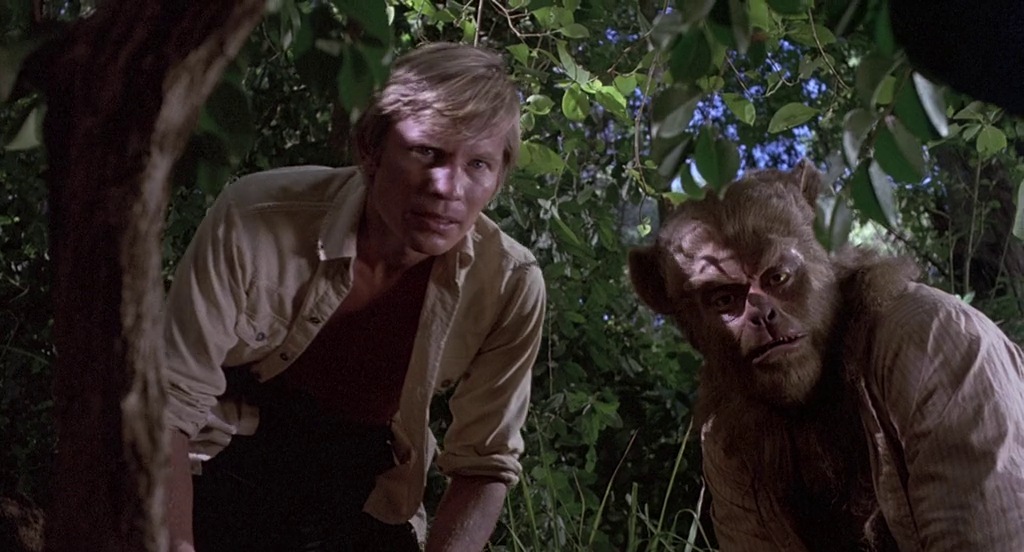There’s a reason filmmakers keep revisiting HG Well’s classic – along with big questions about what differentiates us from animals (if anything), morals versus instincts, etc we get to see a sweaty, terrified hero chased through the bush by shadowy figures that reveal themselves to be more horrible than he could have imagined. All that was necessary a hundred years hence was the visual trickery of Hollywood and a director with enough of an appreciation of the steamy, cloying jungle aesthetic (Apocalypse Now -style) to make it a reality.

All of which makes this film worth watching. More personally I was also interested to see if The Final Countdown director Don Taylor could wrangle a production better than his ill-fated colleague Richard Stanley 20 years later (the cacophony of which is chronicled so brilliantly in Lost Soul: The Doomed Journey of Richard Stanley’s Island of Dr. Moreau). It was also among a group of movies whose box art was seared into my memory, seeing it hundreds of times on video store shelves but never getting around to watching it or realising I should.
If you’ve read the novel or seen the numerous TV or film outings (there are two more coming at the moment, a big screen blockbuster and a TV series from Stanley himself) you know the essential story despite some differences. Luxuriously-haired, Logan’s Run era Michael York plays Andrew Braddock rather than Edward Prendick, a castaway adrift in a lifeboat following a shipwreck somewhere in the South Pacific.
Instead of being rescued by Montgomery and one of Moreau’s experimental life forms while still at sea, he comes across the island alone, finding basic civilisation at an encampment run by the boozy, Great White Hunter type (Nigel Davenport). Montgomery delights in teasing Braddock with ambiguous tidbits about the island and what goes on there thanks to his mysterious employer while the former recovers from exposure and starvation.
In short order he meets the enigmatic scientist/overseer, Dr Moreau (Burt Lancaster) and one of the island’s occupants, Maria (Barbara Carrera), a beautiful love interest invented by writer John Herman Shaner for some Hollywood appeal.

Braddock is both transfixed and horrified as he comes to understand more about what Moreau is doing, importing animals and giving them a special serum to make them more human. If it’s not the Frankenstein’s monster-style antics going on in the compound, it’s the colony of half animal/half human beings who live in the wild and make their home in caves near the shoreline, their savagery barely held back even while they consider Moreau a god of some sort.
But as Braddock comes to learn, Moreau rules through fear rather than benevolence, all the hybrid creatures on his island uttering and believing a series of arcane laws around not eating, drinking or behaving like animals, and all of them in terror at the infamous House of Pain (Moreau’s laboratory) where untold horrors await them for misbehaviour.
As Wells presciently depicted, it can’t last. Back in the late 1890s when he wrote it, scientific culture had barely come to grips with the idea that humans ourselves are risen apes, so there’s a strong undercurrent of cryptoreligious-style warning not to expect animals to behave like men no matter how well they speak or walk on two legs.
A century later, such an outlook was seriously passé, so Shaner’s script and Taylor’s direction is more about how the line between the two blurs, particularly when Moreau, impatient with Braddock’s agitating, captures the younger man and injects him with the serum, prompting Braddock himself to grow shaggy hair and prominent canine teeth, becoming an animal just like the animals Moreau experiments on become human.
There are a few very well staged shots and sequences, in particular one beautifully evocative long shot when Braddock and Maria are escaping the ruins of the compound after Moreau’s creatures have exacted their vengeance, and some great production design in the jungles and beaches of the US Virgin Islands. But the best work might actually be from Planet of the Apes make-up legend John Chambers, who was immortalised in Argo by John Goodman.
Everyone’s on board here so it’s not as batshit crazy as Stanley’s chaotic later effort, and if you’re not familiar with Wells’ ideas it’s a good entry point into the themes he was talking about.
Take a look at the classic trailer here:
Subscribe to FIB’s Weekly Breaking News Report for your weekly dose of music, fashion and pop culture news!






